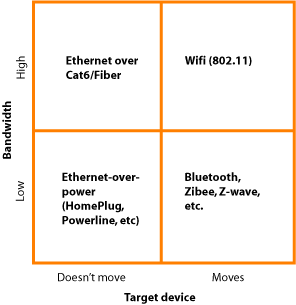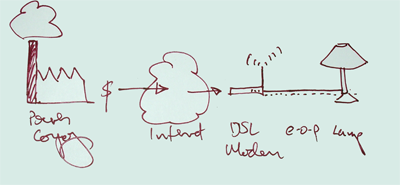This is an outline of a project that I've had on the drawing board for years, and it looks like I'm not going to actually instantiate it, so I decided today (after being prompted by a foo camp mailing list thread) to say screw it and give the idea out to the world, for better or for worse.
The core of my idea is this: that where ethernet-over-power (also known as Powerline, or HomePlug) is useful is for communication with and control of household devices. I've ranted for a long time that there isn't a good appliance communication protocol, but what I've come to realize is that it's not that there isn't a good protocol, but that all the so-called standards that try to solve smart device communications try to reinvent every layer at once. That's shortsighted, because it ends up with mass incompatibilities at all levels, so there is no agreement between device manufacturers at any level, and all of the consortia are just mini-trusts trying to get vendor lock-in so that they can be the sole suppliers of the technology. It's big companies trying to get vertically-integrated vendor lock-in and failing.
Look, folks, we have all of the pieces and we don't have to create any new standards. Here's how I see it:

- Wifi is great for moderately high-speed general-purpose communication to easily-movable end-user devices (and I don't mean just "portable," since this includes things like printers and set-top boxes).
- Cat6 is good for very high-speed communications between devices that don't move.
- Bluetooth, zigbee, z-wave, and all of the other short-haul, low-power, low-bandwidth wireless standards are good for movable devices that need highly near-range communication.
- Ethernet-over-power is good for low-speed communication to static devices.
Anyway, I digress. My point here is to discuss a specific application for Ethernet-over-power. I've been enamored with this technology for a while, but it's struggled in the market by trying to compete with Wifi and failing. The lack of a wire, even if it's a power cable, will always beat out the wire. This competition has lead e-o-p's developers to continue to pour money into making it faster, rather than making the technology cheaper. This has limited its use to a small niche of people for whom neither Wifi nor Cat6 Ethernet works. That's essentially like saying "We're going to make cars for people who like cars that are neither fast, nor capacious, nor cheap." Sure, you'll find some niche, but it's not going to be big.
I feel that the big niche in smart household device communication. Essentially, optional low-bandwidth communication between devices that are already going to be plugged in that helps them work together, but doesn't form the core of their functionality.

Let me give you an example:
- You subscribe your e-o-p-enabled DSL modem to an electricity price service. It gets spot prices every 15 minutes or so from one of the realtime electricity price services.
- It then broadcasts that information as TCP/IP broadcast packets over the local e-o-p network.
- Lights throughout the house/workplace are equipped with a digital dimmer that is listening to power price packets.
- When the price goes over some value (which could be set once a day through a slightly different kind of broadcast packet) the lights go into power-saving mode and dim.
The lamps do not have to be sophisticated Internet-capable devices. They only have to know about a couple of different kinds of packets and to ignore all the other packets, which could be anything from digital picture frames downloading RSS image from the Internet at large, to appliances listening for "what time is it" packets that synchronize all clocks.
The technology all exists. All of it. And I'm sure it's already possible to make it cheap enough that it adds $1 or so to the price of devices at the low end. These devices do not have to be sold in special configurations that only work if you buy a single company's (or consortium's) products, they can just be sold as what they are: lamps, microwaves, picture frames, clocks, etc. The functionality only needs to come into play if you want it, and it device works as advertised whether there are any other devices on the house network or not.
The core value is that this solution creates a market justification for developing inexpensive devices that have the capability of augmented functionality, without requiring that functionality to take center stage in terms of what the devices do. This, I believe, makes the adoption of these devices by consumers more likely, and therefore the further development of such technology, and therefore the network effects that everyone wants. Until people start using the open standards that are already available, they will forever be stuck on lonely, unprofitable islands of proprietary standards, even ones that are touted as open.
[12/31/08 update: I just learned that this is called demand response in the energy business. So I guess what I'm advocating for is technologies for the development of small-scale demand response systems using ethernet-over-power broadcasts of energy pricing information.]



